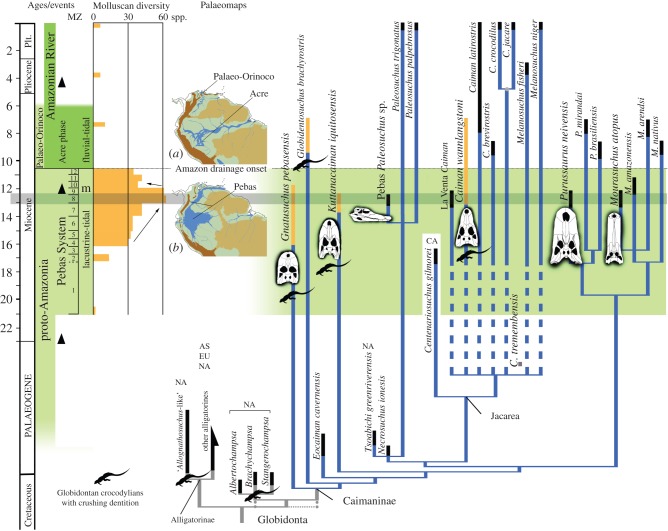Figure 4.
Phylogenetic position of the Pebasian caimanines within the Alligatoroidea. Time-calibrated, strict consensus cladogram of 70 most parsimonious trees (see electronic supplementary material, figure S6 and test S1). Gnatusuchus pebasensis is the most basal caimanine and Globidentosuchus brachyrostris is the next outgroup to all remaining caimanines; these two taxa reveal unknown character states ancestrally present within the caimans (i.e. long splenial symphysis, posterior globular teeth) and their inclusion influenced the topology of relationships within the caimanine clade. Character support provides a novel sister-grouped relationship between the South American caimans and the North American Cretaceous globidontan alligatoroids (i.e. Brachychampsa, Albertochampsa and Stangerochampsa), whereas prior analyses showed either the monophyly of Alligatoridae (Caimaninae + Alligatorinae) exclusive of Cretaceous globidontans [29,30] or, more recently, a polytomy within the globidontan alligatoroids (Caimaninae + [alligatorines and Cretaceous globidontans]) [18,31]. Here, this polytomy (dotted lines) is obtained when the alligatorine Allognathosuchus wartheni is excluded from the analysis. Results also suggest an early diversification of major groups within the Caimaninae dating back to the end of the Cretaceous or Palaeocene interval. (a) The Acre Phase (ca 9 Ma) after intense Andean uplift and onset of the transcontinental Amazon River System. (b) The Pebas Mega-Wetland System in northwestern South America during MZ8 (ca 13 Ma). Stratigraphic distribution of taxa (yellow bars for crushing-dentition caimanines, black lines for other taxa) relative to major Neogene stages and events in Amazonia. Palaeogeographical reconstructions, Andean uplift peaks (black triangles) and marine incursions (m) are from Hoorn et al. [1]. Molluscan Zones and diversity for the Pebas System (MZ1–12) are from Wesselingh et al. [4]. When suitable, internal nodes were time-calibrated with molecular data from Oaks [32]. Darker grey marks MZ8. Alligatoroids are from South America, Asia (AS), Central America (CA), Europe (EU) or North America (NA).

